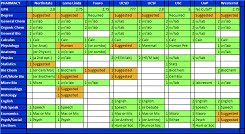There was a lot of information thrown out at us during the presentation, and it started off talking about some nice bullet points about the school.
- UCSF is unique among the other UC's in that it is only a graduate school, and is devoted solely to the health professions.
- 38.000 students in dentistry, nursing, medicine, pharmacy, physical therapy, and a graduate division.
- UCSF medical center is ranked in the top 10 of teaching hospitals in the US.
- The Pharmacy school is ranked #1 in the nation. (Although he did mention that number one in the nation doesn't mean number one for every single individual, and understands that some people may choose differently according to their own needs.)
- First PharmD was given in 1958
- Clinical Pharmacy was born here in 1966
- 65% of student pursue a residency program (Other schools tend to have a much smaller percentage)
A cool fact: When people call the California Poison Control System to get advice about someone ingesting one poison or another, the calls are taken by pharmacists at UCSF, because they are the ones that run the program.
The program is labeled as s four year program... sort of. I am only familiar with semester schools systems, but what was said was that for the people who are familiar with quarter school systems, the program ends with the winter quarter of the fourth year, so the program is actually more like three and a half years.
The current curriculum was introduced in 1998, which means fairly recent, and on top of that they are constantly updating the program based on the advice and feedback from the students.
Now for the curriculum for itself:
- Flexibility to pursue career interests via pathways
- Peer and collaborative learning
- Emphasis on communication and presentation skills (As an aside: It was said that they denied more people based off of communication issues rather than below average GPAs)
- Early exposure to practical issues
- Integration of basic science and clinical application (case-based problem solving)
- Capstone project required of all students (Not even close to a doctoral dissertation or a senior thesis, but it is required.)
About the Pathways
- It is somewhat like a minor
- In your first year everyone takes a class that is an introduction to the pathways
- The pathways are: Pharmaceutical Care, Pharmaceutical Health Policy and Management, and Pharmaceutical Sciences
- Pharmaceutical Care is the more traditional route. Most people choose this.
- Pharmaceutical Health Policy and Management is more population based and not individual based. The emphasis is on health policy, phamacoeconomics, outcomes research (did I type that right?), and application of management techniques
- Pharmaceutical Science is designed to develop skills required for clinical and basic sciences research. There is an emphasis on clinical and pre-clinical research, regulatory affairs, and research administration.
- For more information on the pathways, go here.
About Rotations:
- Rotations are centered around 6 different areas. San Francisco, the South Bay, the North Bay, Davis, Fresno, and the LA/Orange County area.
- Students are placed in one area and do all their rotations there.
- The place you go to is chosen by a lottery. Students rank the areas they want to go to. Students usually get their first or second choice.
- If there is a unique rotation in an area that the student isn't in that they really want to take, arrangements will be made.
- Some students may get exemptions as decided by the student leadership.
That's about it for the quick breakdown of the school and program. More information can of course be found at their website pharmacy.ucsf.edu.





No comments:
Post a Comment